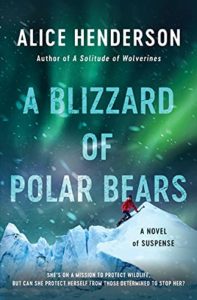 These books – two so far – are a mix of adventure, climate change despair, and appreciation and love of the natural world and the creatures that share the planet with us. In the first book, Henderson’s protagonist, Dr. Alex Carter, left Boston to study wolverines in Montana. As that study winds down in book two, she’s delighted to get a call from a colleague, asking her to fill in for her on a polar bear study in Churchill, Manitoba.
These books – two so far – are a mix of adventure, climate change despair, and appreciation and love of the natural world and the creatures that share the planet with us. In the first book, Henderson’s protagonist, Dr. Alex Carter, left Boston to study wolverines in Montana. As that study winds down in book two, she’s delighted to get a call from a colleague, asking her to fill in for her on a polar bear study in Churchill, Manitoba.
Thrilled, Alex jumps at the chance and hops on a plane. She’s used to solitude and her main points of contact are a buddy who is an actor and her father. While Churchill would be no one’s idea of the big city, to Alex, it almost is, as she’ll be working at a large center with other scientists. She’s happy enough to be able to stay in a motel on her own instead of the center’s quarters.
Much of her work is done out in the wild, however, and where Henderson truly excels are bravura scenes where Alex is out doing her job. The job involves taking a helicopter out to the ice with a grad student assistant, and with the help of the pilot, spotting polar bears, which the scientists then sedate and then proceed to collect hair, blood and other samples to help them determine how the bears are faring.
Not well, it turns out, and the heartbreak of this book is reading about the diminishing arctic ice that restricts the bears hunting of seals. When they can’t get out on the ice, they can’t capture and kill the seals that keep them alive and healthy. Many of the bears are malnourished, though some Alex and her team find have cubs and seem OK.
Into this mix, Henderson of course must introduce some conflict, and of course there is someone out there who isn’t appreciating the results of her study. At first the sabotage is small, and then is becomes massive. There’s a bravura set piece where the helicopter crashes and the three – Alex, the grad student, and the pilot – are fighting for their lives out on the ice.
To me, the action scenes paled in comparison to the recounting of simple survival on the arctic ice, the beauty of the north – there’s a lovely scene featuring the aurora borealis – and the encounters with bears, whether out on the ice or back in Churchill itself.
The action sequences that wrap up the story were, to me, less successful, though they were perfectly adequate. I think when Henderson, a new mystery writer but an actual scientist, marries her storytelling skills to her powerful nature writing, she’ll be tough to beat. As it is, Alex Carter is an excellent protagonist, one who holds my interest and makes me eager for the next book.